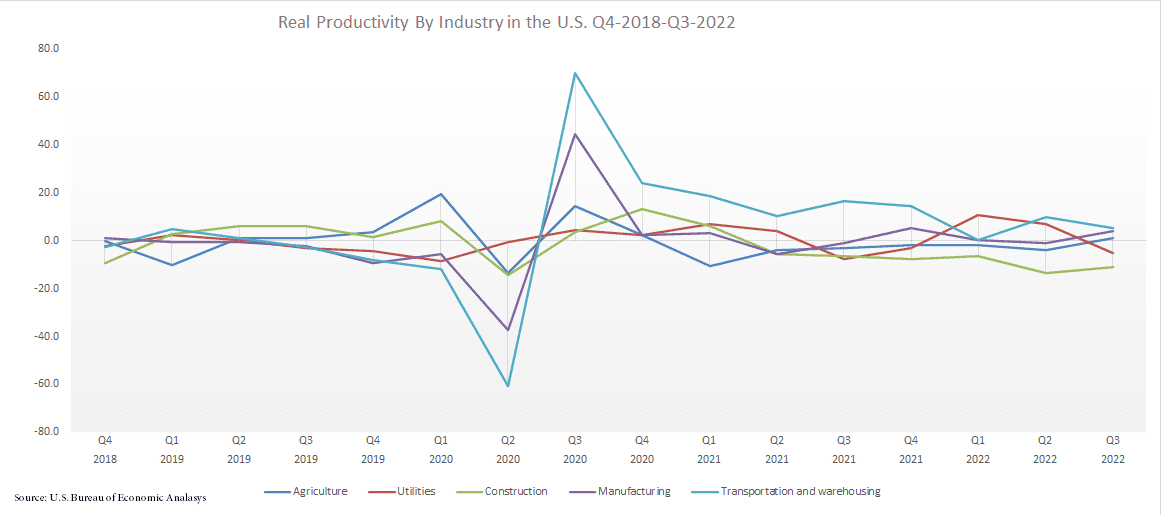
Sub-Committee: Managing Construction Productivity
The construction industry as a whole continues to be challenged by very limited productivity gains. In fact, in many categories of the construction industry, including industrial (non-farm and non-residential), statistical data shows that productivity has remained flat or decreased in recent years.
The description of many of the reasons for poor productivity is well-known to industry practitioners. However, it is difficult, if not impossible, to identify the relative importance of these due to the varying nature of work from project to project. But industry research, surveys, and the work of CURT committees suggest several systemic drivers:
- Unique Projects Built by Varying Teams under Varying Site, Regulatory and Weather Conditions – Construction projects are all different in many ways for often unavoidable reasons. These variations include owners, financial relationships, design, team members, workers, site locations, ground conditions, weather, regulatory codes, etc. These are all reasons why it is so difficult to optimize knowledge, take advantage of past “lessons learned,” and utilize capital-intensive methods which might not work on future projects. There is a need for flexible approaches that minimize risk instead of the most efficient solution for a particular case.
- A Procurement System Based on Competitive Rather Than Collaborative Teams – In many project teams, there is a lack of integration of design and construction and often poor collaboration among team members. This leads to risk-averse behavior as team members try to protect themselves from the impacts of changes caused by errors, omissions and owner modifications. These issues are frequently present on design-bid-build and even design-build projects where some team members submit bids (typically sub-contractors), the low bidders receive awards, and then try to benefit from extra work. The results are projects that are over budget, behind schedule, and more claims. It is not surprising that labor productivity suffers under these conditions.
- Poor Use of Data Based Largely on Paper Documents Produced by a Highly Fragmented Team – The use of paper documents produced by architects and designers working independently, with little or no interoperability, and not able to find many problems until the construction phase, leads to difficulties in coordinating and managing the work effort. For example, there are significant additional costs from capturing and resolving the data from multiple independent sets of plans which are inherent in this process and result in errors, omissions, extra work, and claims (The additional costs of poor data interoperability were documented in a NIST study titled “Cost Analysis of Inadequate Interoperability in the U.S. Capital Facilities Industry” – http://www.nist.gov/manuscript-publication-search.cfm?pub_id=101287 – published in 2004.).
- A Business Environment Characterized by Cyclical Material and Labor Costs – Studies and data shows that the construction industry is characterized by periodic boom and bust cycles. This tends to reduce investment in capital equipment and use of off-site prefabrication, which might not be utilized during a subsequent period of low demand. This reinforces labor-intensive methods, which in turn, puts an emphasis on reducing costs by reducing the training of the labor force and use of the cheapest labor available.
- An Industry Characterized by Many Very Small Firms that Perform a Significant Percent of the Work – The construction industry is characterized by a large number of small firms and relatively few large ones. The smaller firms have difficulty adjusting to more capital-intensive methods (potentially improving productivity) because they cannot make the necessary investment. While it is relatively easy for a small firm to enter the industry, during declines, it is also easy to exit. Thus, there is considerable turnover at the bottom end of the industry, which makes it harder to implement new methods.
CURT members are experts in executing capital projects and we are at our best when we are sharing our experiences and learning from each other. In this committee, CURT owners and contractors will share their experiences and opinions and will discuss alternate approaches for both individual project improvement and the potential for industry-wide system improvements.
Currently, planned work for our committee is centered on these “Focus Areas”:
Interoperability
- Improve / Change the RFI – Change Order process
- Communication between Owner, Engineering, and Contractor (Common tools, data flow alignment, etc.)
- Communication to the craft, (production expectations, metric, goals)
- Minimizing or limiting the impacts of project disruptions
Site Supervision / Leadership
- Manpower/Craft related training, New Hire Assessment / Screening Process
- Analyze and address the Site Leadership Gap
- Need more problem solvers. Taking what you have been given and making it work. Minimize rework.
- How do you identify leaders? Profiling / Selection / Characteristics
- Importance of Mentoring
- Managing Turnover
- Developing the channel to pull labor into the industry
Materials
- Materials Management Handling & Delivery and Tool Management, Supply Chain
- Superintendents completing logistical tasks
- Having the tools, equipment, and plan together
- Having the pieces in the right place at the right time.
- RFID
- Engineering / Fabrication accuracy
- Standardization of material / equipment, minimizing unique pieces
For committee participants, there will be significant opportunities to:
- Discuss and evaluate alternate approaches, share pluses and minuses
- Ask questions, get answers from others based on their experience
- Share experiences
- Collaborate on solutions
- Discuss needs and opportunities for future improvements
